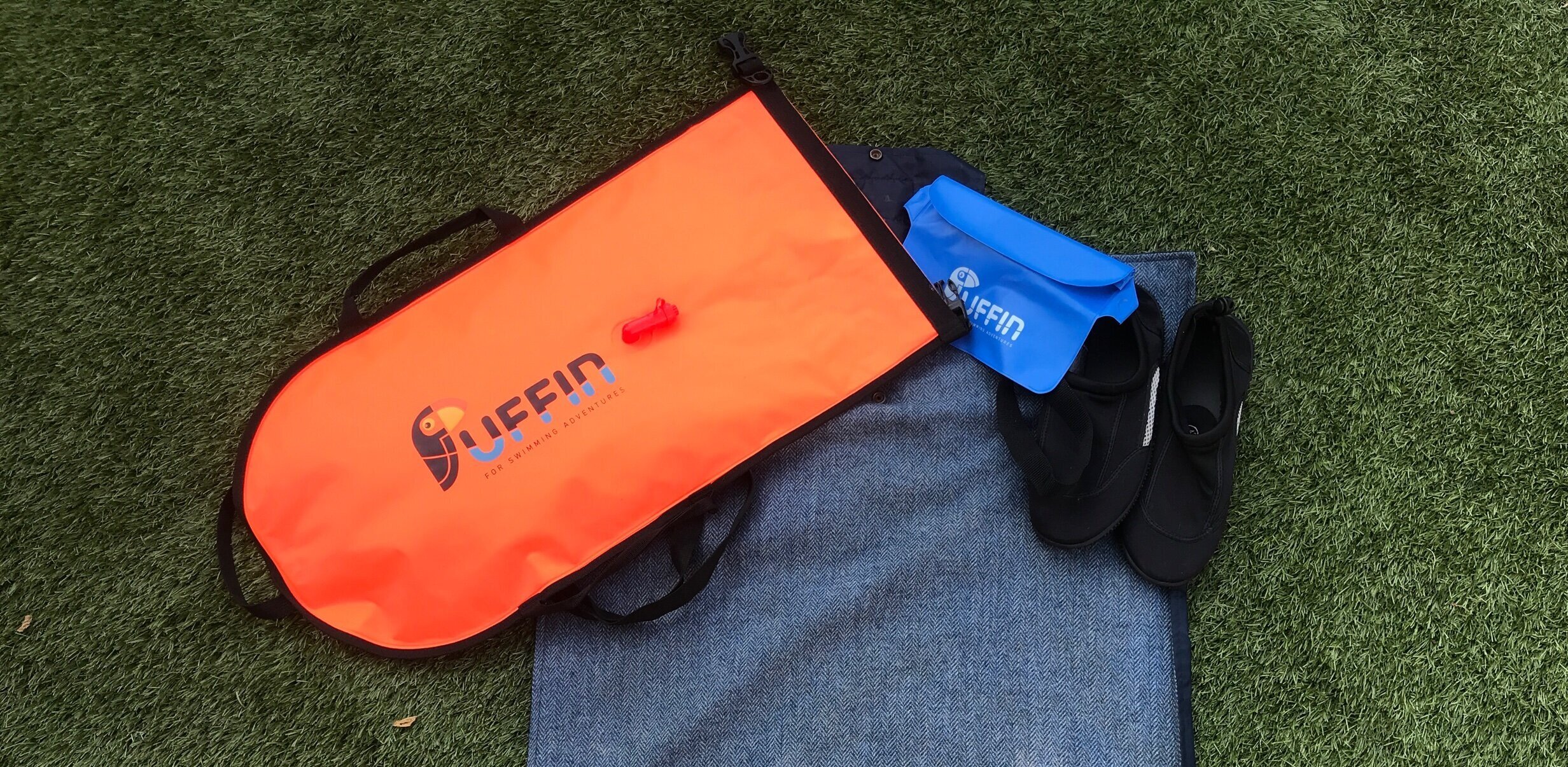
Kit
What do you need to start swimming? Not much, but there are things that will make it more enjoyable.
What do you need?
In order of importance:
Knowledge and understanding of the risks
A pal to swim with or watch out for you
Towel and clothes to get dry and warm afterwards
Water shoes
Something to swim in (but consider undies or skinny dipping if there is no-one around likely to object!)
Something to stand on while you get changed
Tow float
Drink and a snack
Swim hat or woolly hat to keep you warm and visible
Bag for collecting rubbish
In the water
Something to swim in
It’s a good idea to have something to wear in the water. Otherwise people can get upset. But it’s up to you what you wear, depending on your personal preferences and tolerance.
I tend to wear a bikini (the best I’ve found are by Deakin and Blue) because I find them quicker to get out of when I’m getting changed, easier to go to the toilet pre-swim, I like feeling the water on as much skin as possible and also a big two fingers to body shamers. When it’s cold I do add neoprene gloves and socks.
I don’t have much advice to give you about wetsuits - apart from don’t spend lots of money unless you know it’s going to suit you. Wetsuits are designed for different purposes, and you’ll find it restrictive to swim in a wetsuit that’s been designed for something like surfing. Here’s some useful guidance from Outdoor Swimmer.
Goggles
If you are swimming head-up breaststroke you may not want or need goggles. But a pair of quality well fitting goggles are needed if you want to swim freestyle (front crawl), take a look around under the surface or not get too much water in the eyes when it’s windy.
I use Zoggs Predator Flex, which are a popular brand, and I usually wear non-tinted, to try and enjoy the surroundings as much as I can. I also have a pair of Aqua Sphere prescription goggles from here for when I’m not wearing lenses.
It’s worth looking after your goggles - give them a clean with baby shampoo after each use, and store in the fabric bag they come in to avoid scratches.
Water Shoes
It’s a good idea to wear swim shoes, we don’t know what might be on the lake or river bed. Mostly however I wear them because some places are stony and uncomfortable underfoot.
In the winter I wear neoprene socks to keep my feet from feeling like they are going to fall off.
Headwear
There’s lots of different swimming caps available made of different materials and to suit people with a lot of hair to cover. For those of us with long hair they are essential for ‘serious’ swimming, to avoid hair getting in your face. And they make a huge difference when things are a bit chilly.
Lots of people wear woolly hats in the water, particularly in the winter.
Gloves and socks
When the water temperature drops, or if you have problems with your circulation, you’ll feel it in your hands and feet. Neoprene gloves and socks are brilliant for staying comfortable.
Tow Floats
Tow floats are the bright floaty things you’ll see some swimmers pulling along behind them. Usually eye-watering orange or pink, these are inflated and attached by a webbing leash around the swimmer’s waist. I recommend you get one with a dry bag - a compartment you can use for your valuables, like phone and car keys. My favourite is the donut type, which has a dry bag compartment you can actually access while you are swimming (in case your phone alarm starts going off . . . .). Outdoor Swimmer reviewed some of the main brands here.
I’m currently using one from Puffin which is really well made, feels like its going to last (although it isn’t a donut style). They haven’t paid me to say that.
They are not designed to be used as life saving flotation devices, so don’t rely on them if you are not a confident swimmer. The main use is visibility - particularly important in the sea or when there are boats about. They are also lovely on night swims if you put a bike light inside.
(The first time I was told about them, I thought they were called Toe Floats, and you attached them to your big toe. True story).
Other things
ear plugs (I use these ‘soft silicone’ earplugs from Boots when swimming crawl).
a waterproof watch - useful particularly in the early days for keeping an eye on how long you’ve been in the water.
a tracker - I wear a Garmin Swim 2 which is pretty good at tracking my swim (when doing front crawl anyway). If tracking is your thing, you could put a Garmin or your phone in a tow float. You could make something amusing like this.
On the bank
Something to cover you up
Although I am dedicated to peeling away the layers of shame I’ve developed over my life, after the thrill and euphoria of a swim it can still feel like you are back in the PE changing rooms when it’s time to get changed. Transition is known as the fourth discipline in Triathlon, and it is certainly a skill worth developing as an open water swimmer. Afterdrop is a serious issue and it’s important to be able to get yourself dressed and warm quickly before you start shivering.
It is not essential, but many people find a changing robe makes getting dressed easier. These can range from a big dress or coat you already own, to two big travel towels sewn together in a poncho style, to towelling robes, to big snuggly waterproof coats, the most famous brand being the DryRobe. There’s a useful kit review here from the Outdoor Swimming Society.
I own a variety! The DryRobe is brilliant for bad weather. Dressed it in I can feel invincible against wind and rain. But it is bulky, My absolute favourite is a Fourth Element storm poncho. Beautiful and light and cosy, it doesn’t have any zips or openings around the neck, so it can be a bit more difficult to put tops on. (They didn’t pay me to say this either).
Something to stand on
To avoid hopping about inelegantly (well, maybe minimise rather than avoid) I think it’s worth having something to stand on while you drip, shiver and wonder whether it’s really worth putting your underwear on.
But you probably already have something around the house you could use - like a yoga mat, or karrimat, or old towel. Just don’t use something that is likely to make you slip over when you use it on a muddy slope . . .
Shoes and Clothes
Basically - you want clothes and shoes that are easy to put on when you are still a bit soggy and your fingers don’t seem to be working properly. Experiment to find what works for you. Layers are great for keeping and staying warm. Particular favourites of mine are fleece lined crocs. It is swimmers law that underwear after a swim is strictly optional.
A warm hat that you put on as soon as you get out is a great way to start getting warm asap.
Food and drink
Swimming makes you hungry. Hunger leads to grumpiness. So bring a snack with you. Better still, bring snacks for everyone. Best of all, bake a cake and bring it along. You will be very popular.
it may feel like overkill on a hot July afternoon, but a warm drink can be a lifesaver if you stay in too long, and is the perfect way to celebrate a chilly winter dip.
Camera
So you can bore all your followers with endless pictures of your favourite swim spot in slightly varying weather conditions. I use a GoPro in the water - I bought the most basic model available at the time and it suits me very well.
Some places you can buy stuff
From a sustainability perspective, the best piece of kit is the one you already own. But if you do need to buy some bits and pieces, here are some useful sites. They probably won’t be able to compete with the likes of Amazon or Sports Direct on price, but are businesses or organisations that are involved in outdoor swimming.





